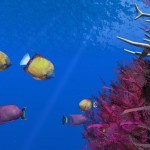 So I’m buzzin’ through the internet looking for inspiration towards a logo for a new project from the Harte Research Institute when I stumble upon this website touting the wonders of “Neptune Krill Oil” (NKO) – “the purest combination of phospholipids, antioxidants, omega-3, omega-6, and omega-9 fatty acids.” Hail distraction. Consider this a companion piece to Craig’s “Why don’t all whales have cancer”, below.
So I’m buzzin’ through the internet looking for inspiration towards a logo for a new project from the Harte Research Institute when I stumble upon this website touting the wonders of “Neptune Krill Oil” (NKO) – “the purest combination of phospholipids, antioxidants, omega-3, omega-6, and omega-9 fatty acids.” Hail distraction. Consider this a companion piece to Craig’s “Why don’t all whales have cancer”, below.
The sweetly monikered krill-oil product from Krill Bill claims a 15:1 ratio of omega-3 to omega-6 fatty acids, compared to 3:1 ratio for fish oil fatty acids. That’s an impressive benefit. Who knows? Maybe it’s a good way to get your omega-3 fatty acids, eating from the bottom of the food chain, without subjecting yourself to the heavy metals you find in fish these days.
So where does NKO come from? The krill oil is extracted from Antarctic krill (Euphausia superba) “on-site”, presumably on-board a catcher-processor ship operating on high-seas in the Southern Ocean. The krill they target are fascinating, and fairly well studied. Euphausiids can occur in “super-swarms” so dense (60,000 individuals per cubic meter) and so large (450km across) that the biomass of a single super-swarm (est. 2 million tons) rivals the global annual fish catch of some heavily fished species like tuna and cod (Macaulay et al. 1984, Knox 1994).
Some say the krill abundance in the Southern Ocean is high because the standing stock of their predators is low. Blue whale and fin whale populations in the Southern Ocean are less 10% of their peak abundance before commercial whaling (Chapman, 1988). Therefore, krill populations may be experiencing some kind of predation release. Crab-eater seals are also known predators, though, and the seals are still numerous in Antarctica.
Individual E. superba can live to be > 7 years old and grow to the size of Texas Brown Shrimp (about 3-4 inches). Don’t expect to see them on your dinner plate anytime soon, though. The high fluoride content in krill makes them toxic to humans. The USSR found a way to compensate for this by shelling or flash-freezing them, and they created a new outlet for krill-butter and the krill based protein paste somewhere in Siberia in the late 1960’s and early 70’s.
New York based NKO distributor “Krill Bill” website posts several studies claiming the krill-oil product lowers cholesterol, reduces inflammation of the joints, increases flexibility, prevents UV damage to the skin, and improves physical appearance. Unfortunately, I don’t see any journal citations so we can’t be sure that all Craig’s problems are solved just yet…
References:
Chapman, DG. 1988. Whales. Oceanus, 31, pp. 64-70.
Knox, G.A. 1994. The Biology of the Southern Ocean. 444pp. Cambridge University Press. Cambridge, UK.
Macaulay, MC, TS English, OA Mathiesen. 1984. Acoustic characterization of swarms of Antarctic krill (E. superba) from Elephant Island and Bransfield Strait. Journal of Crustacean Biology, 4:1. pp. 16-44.






Ha, at first I thought you meant this Krill Bill. More here.
Great stuff! the “Lord of the Lings” takes the cake.
http://www.montrealgazette.com/news/Sherbrooke+explosion+Firefighters+environmentalists/7525034/story.html
http://www.neptunebiotech.com/
Acetone is believed to the the cause.